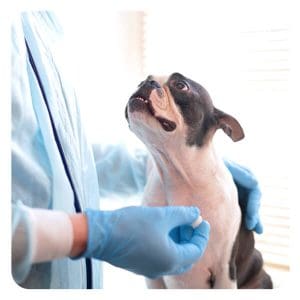
What is the difference between spaying and neutering?
Female dogs are spayed, and male dogs are neutered.
During a spay surgery, the female dog’s reproductive organs are removed, including the ovaries and uterus. Once spayed, the female dog will no longer go into heat or be able to reproduce. In many cases, behavior issues that are related to the urge to mate will disappear.
When a male dog is neutered, his testicles and related structures are removed. The dog will no longer be able to reproduce, and any mating related behaviors will be diminished or cease completely. However, dogs who are neutered when they are older may still display some breeding instincts.
It is important to remember that spaying or neutering a dog is a routine procedure that is quite safe. You can ease your concerns by discussing the procedure with your veterinarian and learning more about the process. They can provide you with all the information that you need and answer any questions that you may have. By understanding the procedure, you will be better equipped to take care of your dog both before and after the surgery.
Why should dogs be spayed or neutered?
It’s not just about preventing unwanted puppies, although that is certainly important. Spaying or neutering also offers a host of health benefits for your pet that can help him or her lead a longer, healthier life.
For example, spaying reduces the risk of mammary cancer and completely eliminates the possibility of a life-threatening uterine infection called pyometra.
Neutering eliminates the risk of your dog developing testicular cancer and reduces the risk of prostate issues, including prostate cancer. Neutered males also tend to be less aggressive and less likely to wander off in search of a mate, putting them at risk of getting hit by a car or injured in some other way. Female dogs that are spayed are less likely to experience mood swings associated with their heat cycle.
When should your dog be spayed or neutered?
Most vets recommend performing the surgery at around four to six months for most dogs. Experts at Bond Vet dog spay/neutering clinic recommend waiting until male dogs are fully grown before neutering and bitches have their first heat to prevent skeleton, joint, and formation problems. Be sure to consult with your veterinarian for advice based on your dog’s age and breed.
Before the Surgery

Pre-surgery blood work is usually required as well. This is important for checking the function of your pet’s liver and kidneys to ensure they don’t have any underlying conditions and that they’ll be able to handle the anesthesia safely.
The bloodwork will also verify platelet function to ensure that his or her blood clots normally, red blood cell count to rule out anemia, and immune function to rule out an increased risk of infection.
On the Morning of the Surgery
Your vet will provide you with pre-surgery instructions. Most likely, they will request that you don’t feed your pet the night before or the morning of the surgery. In most cases, you’ll be asked to drop your dog off early in the morning and pick up at the end of the day, once he or she is fully awake.
During the Surgery Itself
Spay and neuter surgeries are performed with the dog under general anesthesia. This is necessary for the procedure to be conducted safely. Your pet won’t experience any pain or anxiety, and he’ll remain perfectly still the entire time.
The doctor will also administer injectable pain medication before the procedure starts. Basically, your pup will just take a nap through the whole thing! While under general anesthesia, the veterinarian will perform the spay or neuter procedure as quickly and efficiently as possible to minimize the time that your dog is under anesthesia. The procedure itself typically takes between 30 minutes and an hour, depending on whether your dog is being spayed or neutered. During this time, the vet will remove the necessary reproductive organs and close the incisions with sutures. The doctor and staff will monitor your pet’s breathing rate, blood pressure, heart rate, reflexes, and gum color throughout the entire surgery, too.
After the procedure, he or she will be kept comfortable while waking up from the anesthesia and the staff will give you a call to let you know how everything went. The vet will also provide you with detailed instructions on how to care for your dog during their recovery period.
After the Surgery

Every vet will provide their own list of post-operative care instructions, but here’s a general idea of what to expect:
- If you receive any medications, be sure to administer them as instructed to prevent infection and pain.
- Do not take your dog’s Elizabethan collar off. Any licking at the surgery site could cause infection, irritation, or even rip out his stitches- all of which could require another trip to the vet.
- Activity should be limited for 10 days to allow for healing.
- Monitor the incision site for signs of infection and watch for any sign that your pet isn’t feeling well. The doctor will tell you what to look for.
- Don’t bathe your dog or let him go swimming until the surgery site is completely healed, usually a minimum of 10-14 days.
Complications after spay or neuter surgery are very rare, but they can happen, so be sure to follow your vet’s post-op instructions carefully. The hardest part will be getting them to stay calm and rest, but it’s super important.
What to Expect Post-Recovery
Rest assured that your pup will still be just as sweet and loving as there were before the surgery. Their fundamental personality won’t change.
However, you may notice that your male dog is less likely to hump, and he doesn’t urine mark as much as he used to. He may also be less aggressive if this was a problem for him before.
It’s rare, but some females become a bit lazier after they’re spayed. They may also have a larger appetite, which could lead to unhealthy weight gain. You should also keep in mind changed metabolic rate so constant weight check is important for both females and males.
Now is a great time to begin working on some training with the Dogo app to keep your pup active and engaged! If your pup is new to training, try Our Basic Obedience Program to get them familiar with basic commands.
If he already has some skills, the Stay Active Training Program is a great choice. It’s designed to teach your dog 12 new skills and strengthen their muscles. It’s tons of fun for your dog and you!






